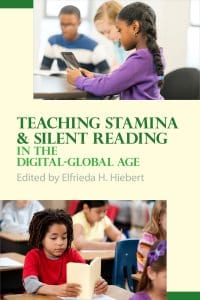
In all likelihood, you are reading these words silently. Silent reading is the mode in which adults typically read. In the primary grades especially, and sometimes even beyond in school, oral reading dominates. Oral reading is a fairly good predictor of automaticity in recognizing words in silent reading, but the transfer between oral and silent reading is not a perfect one by any means. In oral-reading contexts, a teacher typically keeps tabs on whether students are reading. In silent reading, students need to monitor themselves.
A significant number of American students do relatively well on oral-reading assessments, but in independent-reading contexts such as state assessments, many engage in unproductive reading behaviors. If the text is short, they may do reasonably well, but when the text gets longer, a sizable group of students begin to skip around the text or jump to questions without reading.
Often, word recognition is seen to be the culprit for these behaviors of students. However, the majority of students have fairly accurate word recognition by the end of third grade.
The problem lies with their lack of automaticity at recognizing word meanings, which, in turn, stems from an insufficient amount of reading in school.
To become proficient at anything—whether it is surfing, drawing, or reading—requires spending substantial time in the activity. Without extensive reading, students’ stamina as readers will be inadequate for the tasks of community, college, and careers in the 21st century. Stamina refers to the ability to stay on task during silent reading.
Following are three ways to increase the amount that students read silently with the aim of building their stamina as readers.
First, provide students with daily opportunities to read magazine articles. For struggling readers, reading an article is likely to be viewed as achievable, since articles are typically short and pertain to engaging topics. A great resource is the Article-a-Day initiative of readworks.org, a nonprofit with approximately 4,500 free, downloadable articles. Second, divide extended texts into chunks, which students read silently. Teachers can guide students in learning to set purposes as they read parts of texts. Talking Points for Kids (free and downloadable at Textproject.org) are presented in sections around a topic, making them ideal for supporting struggling readers in reading extended texts.
Third, have frequent conversations with students about their capacities as readers. Many students do not have a realistic sense of what they can read or what to expect from texts. The majority of words in texts come from a relatively small group—about 2,500 word families (e.g., help, helpful, helpless, unhelpful). Demonstrating to students that they know the majority of words in a text can be useful in increasing their confidence as readers. Stamina is not something that develops overnight but rather requires extensive opportunities to read over a school career. As they read, students need to be supported in reflecting on what they are learning from texts. Reading is not a school exercise done for practice. Reading begets knowledge and knowledge opens opportunities.
Elfrieda Hiebert is the CEO/president of TextProject. She has had a long career as a literacy educator in California and, subsequently, as a teacher, educator, and researcher at the universities of Kentucky, Colorado-Boulder,Michigan and California – Berkeley. Her research, which addresses how fluency, vocabulary, and knowledge can be fostered through appropriate texts, has been published in numerous scholarly journals and books. Through documents such as Becoming a Nation of Readers (Center for the Study of Reading, 1985) and Every Child a Reader (Center for the Improvement of Early Reading Achievement, 1999), she has contributed to making research accessible to educators.https://tinyurl.com/y7bbr443








